 It seemed strangely familiar: the parched, barren hills around Arroyo Seco, the crowds, the lines of cars, police directing traffic, signs pointing to the Rose Bowl — all recalled the last time I had been in Pasadena, more than thirty years ago, to watch the famed football tournament.
It seemed strangely familiar: the parched, barren hills around Arroyo Seco, the crowds, the lines of cars, police directing traffic, signs pointing to the Rose Bowl — all recalled the last time I had been in Pasadena, more than thirty years ago, to watch the famed football tournament.
Then tens of thousands of people had crowded into the stadium to watch a small piece of leather being moved back and forth on a field a hundred meters long.
Now, a few miles away at Jet Propulsion Laboratory (JPL), scientists, spectators and a thousand members of the press had assembled because of another inanimate object. This one was more than a billion kilometers away, ten times farther than the Sun, racing toward Saturn at 70 thousand kilometers an hour. The spacecraft was so far away that radio messages traveling at the speed of light took an hour and a half to reach it, or us — light from the sun, traveling at the same rate, takes only eight minutes. Yet far more people were watching the distant encounter than had seen the early Rose Bowl games at the dawn of the television era, for Voyager 2's exploration of the ringed planet was being televised across the nation and carried to many other countries.
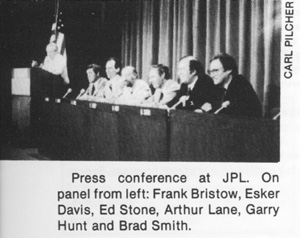
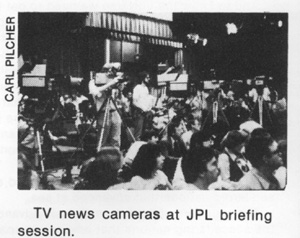 In addition to the crowds at JPL, thousands more were nearby in downtown Pasadena attending Voyager exhibits and activities presented by the Planetary Society, an organization formed by Carl Sagan and JPL director Bruce Murray to enlist public support for space exploration. Highlights of the festival included a symphony concert conducted by John Williams and narrated by Sagan; an exhibit of space art; informal appearances by scientists, astronauts, authors and other public figures; continuous showings of space films; and two evening panel discussions in the Civic Auditorium.
In addition to the crowds at JPL, thousands more were nearby in downtown Pasadena attending Voyager exhibits and activities presented by the Planetary Society, an organization formed by Carl Sagan and JPL director Bruce Murray to enlist public support for space exploration. Highlights of the festival included a symphony concert conducted by John Williams and narrated by Sagan; an exhibit of space art; informal appearances by scientists, astronauts, authors and other public figures; continuous showings of space films; and two evening panel discussions in the Civic Auditorium.
On Monday night, just 24 hours before closest approach, a large audience heard four scientists summarize changes in perspectives resulting from twenty years of planetary exploration. Gene Shoemaker, of the Voyager imaging team and U.S. Geological Survey, stressed the importance of collisions between solid bodies. He reviewed evidence for collisions all across the solar system, from Mercury to Earth and the Asteroids out to the Saturn system. To highlight the transformation in scientific thinking he recalled that when he first examined Arizona's Meteor Crater 25 years ago:
... it was generally considered by my geological colleagues to be a risque idea that something would fall out of the sky and make a hole in the ground. Even though there was abundant evidence to indicate that this crater, which is almost a mile across, was formed by the impact of a meteorite — fragments strewn for six miles in all directions from the center — it was still a very controversial idea.
On August 25th, a few hours before Voyager's closest approach to Saturn, Garry Hunt of the Imaging Science Team described the emotional aspects of the encounters with Jupiter and Saturn.
The millions of words and hundreds of books that may be written about Voyager results will never be able to actually show the emotion going through all of us here. It's an incredible feeling. The excitement of seeing for the first time what nobody has ever seen before. Seeing Amalthea for the first time. No one had ever seen the braided rings before. We couldn't believe it. Seeing the structure in the Red Spot for the first time. It's a very personal feeling you cannot really describe.
The excitement keeps us going. We're all very tired. We work 18 to 20 hours at a stretch. You daren't go to bed because something may come through that you've never seen before; Why should you miss it? Tonight is an example: the closest approach to Saturn is one thing. But will the spacecraft survive? What's going to happen when it gets around to the dark side? God will know an hour and a half before us. Why should he have the secret? So we wait up till after midnight.
This is a special time, to be a part of an amazing mission that discovered so much: the rings around Jupiter, the ringlets, the new moons, Hyperion in its various forms from a beer can to a hamburger pattie. It's like a huge circus. Who knows what tomorrow will bring?
An ominous answer came a few hours later with the announcement: "The Voyager 2 scan platform has developed a problem. This platform is articulated in 2 dimensions ... The platform is stuck in azimuth (side to side) but free to move in elevation (up and down)."
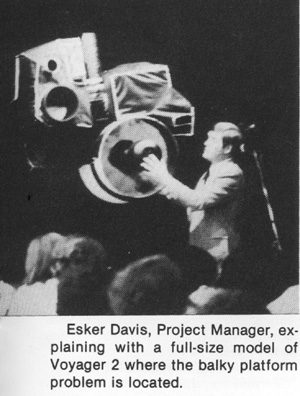 As a consequence: "We have only one high resolution Enceladus mosaic instead of three. One of 2 high resolution mosaics of Tethys. . . "
As a consequence: "We have only one high resolution Enceladus mosaic instead of three. One of 2 high resolution mosaics of Tethys. . . "
Despite the very regrettable loss of some information which we probably will not be able to obtain again in our lifetime, Voyager 2 sent us a tremendous volume of data, some supporting earlier hypotheses, some contradicting them, and all adding to our knowledge of Saturn and the solar system. There is only room here for three examples:
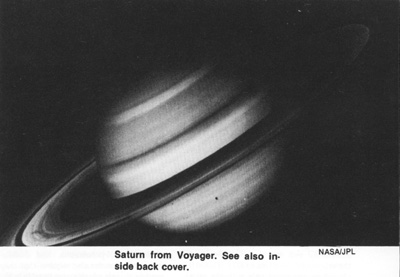 Using the spacecraft's radio to determine particle sizes as the signal passed through the rings, analysts concluded that the average size of particle in the A-Ring is 10 meters, in the outer part of the Cassini Division 8 meters, and in the C-Ring 2 meters.
Using the spacecraft's radio to determine particle sizes as the signal passed through the rings, analysts concluded that the average size of particle in the A-Ring is 10 meters, in the outer part of the Cassini Division 8 meters, and in the C-Ring 2 meters.
Although Voyager 2 gave much attention to the spoke-like structures in the B-Ring, they continue to defy explanation. One theory proposed that the spokes are electrostatically levitated particles of fine dust, lifted above the plane of the rest of the B-Ring by Saturn's magnetic field, but the three pictures taken during ring plane crossing showed no evidence of particle levitation.
Phoebe, the outermost satellite of Saturn, is about 190 kilometers in diameter, twice as large as previously measured from earth, and is probably a captured asteroid.
[Photo below is from the inside back cover of the magazine.]
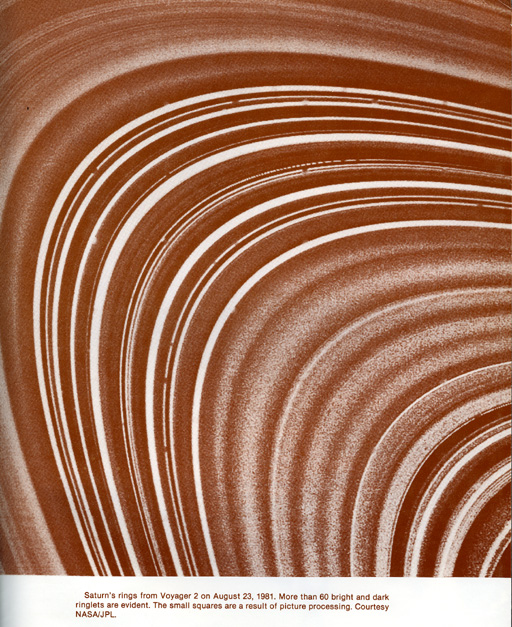
Every day a wealth of such reports poured forth from JPL's Public Information Office. To get a preliminary assessment of the relative importance of the findings I asked David Morrison of the imaging teams what he thought were Voyager 2's most important Saturn discoveries. He replied:
"Two clearly are at the top of the list. One is the degree of fine structure and dynamism in the rings. I think the most spectacular single picture from Voyager 2 is the one in which you try to line up the two parts of the B-Ring and find that they do match in fine scale structure. Just the existence of structure down to the kilometer and sub-kilometer level is fascinating. The fact that it is clearly wave motion, that when you're looking at the rings you're not looking at a static structure but at something that's more like the waves on the surface of an ocean, I think is the main thing. We did not get that close a look with Voyager One at the rings. So that is new.
The second major discovery is Enceladus. To have discovered a small satellite which has no right to be geologically active, to discover that it IS geologically active, that it has youthful surface, is completely unexpected, and leaves us with essentially having to explain the existence of some heat engine inside Enceladus, which we had no reason to anticipate.
Those are clearly the top finds. Then there are some other things, perhaps more interactive with Voyager One. The discovery that the outer edge of the B-Ring is an ellipse with Saturn at the center instead of at one focus, and the kind of orbital resonances which produce that, was quite unexpected.
The fact that we did not find the embedded moons, that we thought were causing gaps was unexpected. The fact that we found no new satellites at all is sort of surprising. The fact that we found kinks in the ringlets inside the Keeler Division but did not find kinks or braids in the F Ring this time is certainly confusing.
Clearly the fact that the camera was taking better pictures of Saturn this time and the atmosphere was more active provides a wealth of new data for the atmospheric dynamicists, a lot more than Voyager One did.
Hour after hour, day after day, pictures of the distant planet, its rings and its satellites were on the closed circuit television monitors in the offices, laboratories, auditorium and cafeteria at JPL. The mood of the watchers was a mixture of joy and sadness, of elation and concern: elation over the success of the Voyager encounters with Jupiter and Saturn, but sadness that this might be the last planetary encounter for a long while, perhaps for our lifetimes.
Along with questions raised by the intriguing information pouring in from Saturn, there were also questions about the future of the space program in general. When will other spacecraft be launched, craft which take years to plan and build, and still further years to travel through interplanetary space? What about more traditional activities, such as ground based astronomy? What about projects whose support is precarious even during more favorable times, projects such as the search for extraterrestrial intelligence?
And what about the Voyagers themselves?
The Voyagers will continue their virtually endless journeys out of the solar system, and Voyager 2 could send us information about Uranus and Neptune. But will there be a scientific team at JPL in 1986 and 1989 to receive and analyze the data?
It would indeed be ironic if this craft, built to journey through interplanetary space for a million years, carrying information about Earth to the still unknown civilizations around distant stars, is forgotten by us, its makers, even before it leaves our own solar system.
 David W. Swift covered the voyager 2-Saturn encounter at JPL for COSMIC SEARCH. A PH. D. from the University of California at Berkeley, Dr. Swift is Professor of Sociology at the University of Hawaii and a Contributing Editor of COSMIC SEARCH.
David W. Swift covered the voyager 2-Saturn encounter at JPL for COSMIC SEARCH. A PH. D. from the University of California at Berkeley, Dr. Swift is Professor of Sociology at the University of Hawaii and a Contributing Editor of COSMIC SEARCH.
![[NAAPO Logo]](../../Images/NAAPOsm.jpg)
![[NAAPO Logo]](../../Images/NAAPOsm.jpg)